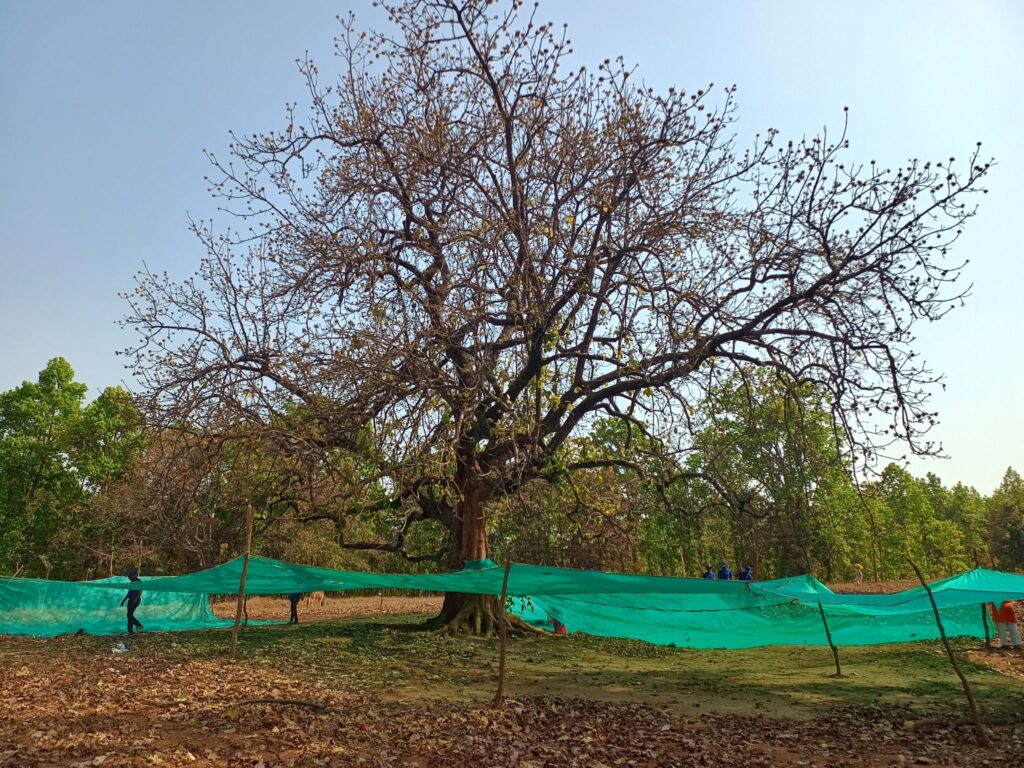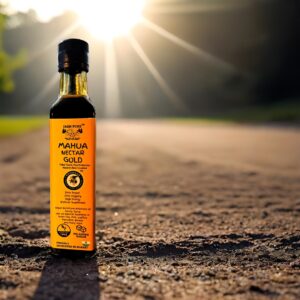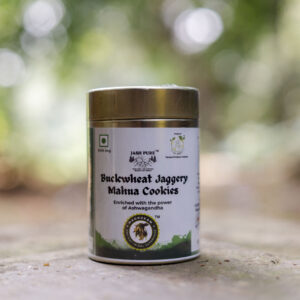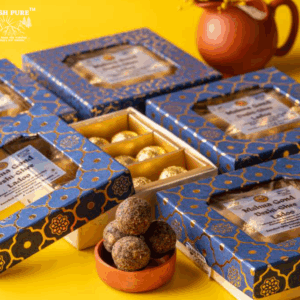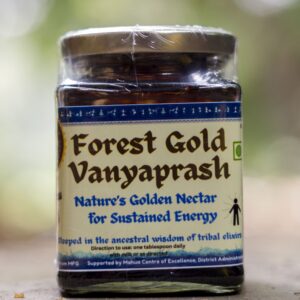Introduction – Why Mahua Matters as a Keystone Species
The Mahua tree (Madhuca longifolia) has been called many names: kalpavriksha (wish-fulfilling tree), the tree of life, and even a family jewel passed from one generation to another. For tribal families across central India, Mahua means food security, cultural continuity, and income. For ecologists, it is a keystone species — one that sustains biodiversity and ecosystem resilience in ways far greater than its abundance might suggest.
Yet, despite its ecological and cultural centrality, Mahua remains marginal in mainstream discourse. Most Indians associate it with local liquor, overlooking the fact that its flowers, fruits, leaves, bark, and seeds support an entire web of life — from honey bees and fruit bats to elephants, sloth bears, and humans. Understanding Mahua’s ecological role is essential not just for conservation, but for shaping sustainable futures that respect indigenous knowledge and biodiversity.
1. Mahua in Indian Forest Ecosystems
Mixed Deciduous Forest Anchor
Mahua thrives in mixed deciduous forests of Chhattisgarh, Madhya Pradesh, Jharkhand, Odisha, and Maharashtra. It coexists with sal (Shorea robusta), palash (Butea monosperma), and kusum (Schleichera oleosa). In these landscapes, Mahua contributes to species richness, soil fertility, and forest productivity.
A study in Odisha found 94 tree species across 29 families in Mahua-dominated forests, emphasizing that the tree does not stand alone but supports diverse ecosystems. Its shade, root networks, and leaf litter enrich the soil, enabling companion species to thrive.
Seasonal Nutritional Buffer
The flowering period (March–April) is critical. At this time, other food sources are scarce — crops are harvested, but summer vegetables and fruits are not yet abundant. For wildlife, this lean season could be disastrous. Mahua steps in as a nutritional buffer, offering sugar-rich flowers and later fleshy fruits that feed a multitude of species. This makes it ecologically invaluable.
2. The Web of Life Sustained by Mahua
Birds and Insects
Nectarivores like parakeets, green pigeons, and sunbirds forage directly on Mahua blossoms.
Insectivores such as mynas, drongos, babblers, and bee-eaters feed on insects swarming around flowering trees.
Pollinators including bees, moths, and beetles help cross-pollinate blossoms, ensuring fruiting success.
Mammals
Fruit bats are the unsung heroes of Mahua forests. They not only pollinate but also disperse seeds across wide areas. Without them, regeneration falters.
Large mammals such as elephants and sloth bears rely on Mahua fruits and flowers. Bears especially forage intensively on blossoms, while elephants are drawn to the scent of fermenting flowers.
Small mammals including civets, porcupines, and squirrels also depend on Mahua during summer.
Humans
According to a report by the Chhattisgarh State Institute of Rural Development, nearly 75% of India’s indigenous population engages in Mahua flower collection. For them, Mahua is food security, seasonal income, and a cultural cornerstone.
This intricate web of interactions demonstrates why Mahua is rightly called a keystone species. Its loss would ripple across multiple trophic levels.
3. Human–Wildlife Conflict and Mahua
Sloth Bear Conflicts
In Madhya Pradesh’s Kanha–Pench landscape, sloth bears rely heavily on Mahua blossoms. Human collectors entering forests at dawn to gather flowers often encounter bears, leading to tragic confrontations. Reports suggest that bear-related fatalities in this region exceed those from tiger encounters — a striking reminder of Mahua’s role in human–wildlife dynamics.
Elephants and Mahua
Elephants are drawn to the fermenting smell of fallen flowers and fruits. During Mahua season, they stray into villages and fields, causing crop damage and sometimes human casualties. Communities often perceive these raids as linked to Mahua’s intoxicating pull.
Conflict Management
Conservationists propose community orchards, barricaded collection zones, and night patrols as strategies to reduce risks. Integrating indigenous knowledge — such as timing collection to avoid peak animal foraging — is equally vital.
4. Regeneration Challenges
Declining Seed Dispersal
Field researchers note an alarming scarcity of Mahua saplings compared to companion species like kusum or palash. The decline of fruit bats, primary seed dispersers, and the practice of harvesting fruits directly from trees both limit regeneration.
Overharvesting
When households prioritize immediate income, flowers and fruits are collected excessively, leaving little for wildlife. Over time, this undermines forest resilience.
Habitat Fragmentation
As forests are cleared for mining, infrastructure, or agriculture, Mahua populations become isolated. Fragmentation reduces genetic diversity, weakening long-term survival.
5. Traditional Knowledge and Cultural Practices
For centuries, tribal communities have developed sustainable practices:
Women inherit rights to Mahua trees, treating them as family assets.
Cultural taboos limit overharvesting — blossoms are shared with neighbors, ensuring equitable access.
Festivals and rituals reaffirm Mahua’s sacred status, embedding conservation into culture.
But modern pressures — wage labor, urban migration, and youth disengagement — threaten this knowledge. As elders pass away, ecological wisdom risks being lost.
6. Emerging Conservation Strategies
Community Orchards and Safer Harvesting
Setting up community-managed orchards near villages reduces encounters with bears and elephants, while nets and elevated platforms ensure hygienic, food-grade collection.
Agroforestry Integration
Agroforestry models integrate Mahua with faster-yielding crops like mango or chikoo, offering short-term income while maintaining Mahua’s long-term ecological value.
Urban Afforestation & Sacred Groves
Projects in Mumbai’s Aarey Forest and Bhimashankar sacred groves show that urban and peri-urban ecosystems can also host Mahua, reconnecting communities to their forest heritage.
Premium Product Development
From bioethanol and biofertilizers to cookies, teas, and nutraceuticals, Mahua’s transformation into value-added products creates economic incentives for conservation. The more communities benefit, the stronger their stake in protection.
7. The Double-Edged Sword of Mainstreaming
As Mahua becomes trendy in urban markets — whether as craft spirits or branded superfoods — a danger emerges. Over-commercialization could undermine sustainability if ecological limits are ignored. Ecologists warn of the commodification trap, where short-term profits overshadow long-term conservation.
Balancing mainstreaming with ecological integrity is therefore essential. Policies must safeguard forest rights, incentivize sustainable harvesting, and recognize Mahua’s dual role as cultural heritage and ecological anchor.
8. Global Context – Mahua and the SDGs
Mahua conservation intersects with several UN Sustainable Development Goals (SDGs):
SDG 2 (Zero Hunger): Nutrient-rich flowers combat malnutrition.
SDG 5 (Gender Equality): Women-led SHGs drive Mahua value chains.
SDG 13 (Climate Action): Mahua’s drought resilience strengthens adaptation.
SDG 15 (Life on Land): Protecting Mahua sustains biodiversity.
Positioning Mahua within global sustainability frameworks can attract policy attention, research funding, and eco-conscious consumers.
Conclusion – Towards a World Where Mahua Thrives
Mahua is more than a flower. It is a keystone species, a cultural treasure, and a lifeline for biodiversity and tribal livelihoods. Its seasonal abundance feeds birds, bats, bears, elephants, bees, and humans alike. Its conservation is therefore not optional — it is essential.
Protecting Mahua requires an integrated approach: reviving traditional knowledge, investing in agroforestry, preventing overharvesting, and creating market incentives aligned with ecological sustainability.
In an era of climate change and biodiversity loss, Mahua offers a model of resilience — a reminder that indigenous trees can be both nutritional superfoods and ecological keystones. By championing Mahua, we champion a vision of coexistence between people, forests, and wildlife.
References
Vaidyanathan, S. (2024). Mahua’s Ecological Entanglements. Mahua Matters, Sept 8.
Patel, M., & Naik, S. N. (2010). Flowers of Madhuca indica J.F. Gmel.: Present status and future perspectives. IJNPR, 1(4), 438–443.
Dwivedi, A., Priyadarshini, A., & Induar, S. (2022). Mahua flower and its application in food industry: A review. IJCS, 10(1), 80–84.
Singh, R.P., & Upadhyay, S.K. (2008). The beneficial effects of feeding Mahua (Bassia latifolia Roxb.) flower syrup to honey bee colonies. J Apicultural Research, 47(4), 261–264.
Jha, P., et al. (2013). Improvement over traditional brewing techniques for Mahua-based bioethanol. IJESM.
Patel, P., et al. (2017). Endophytic microbes from Mahua blossoms improving soil fertility. JPAM.
Chhattisgarh State Institute of Rural Development. (2019). NTFP and Tribal Livelihood Report.
Handpicked for You
-
Mahua Heritage Collection
Mahua Nectar Gold
Rated 0 out of 5₹699.00Original price was: ₹699.00.₹655.00Current price is: ₹655.00. INR Add to cart -
Wholesome Bakes
Buckwheat Jaggery Mahua Cookies
Rated 0 out of 5₹175.00Original price was: ₹175.00.₹170.00Current price is: ₹170.00. INR Add to cart -
Forest Sweets & Treats
Desi Ghee Mahua Gond Laddoos
Rated 0 out of 5₹350.00Original price was: ₹350.00.₹340.00Current price is: ₹340.00. INR Select options This product has multiple variants. The options may be chosen on the product page -
Mahua Heritage Collection
Forest Gold Vanyaprash – Pure Mahua Wellness Paste
Rated 0 out of 5₹575.00Original price was: ₹575.00.₹550.00Current price is: ₹550.00. INR Add to cart

